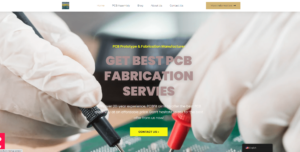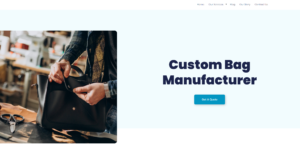Blog
The Ultimate Material Selection Guide for Bag Design
Welcome back to another valuable process in the incredible journey of bag design. In our previous encounter, we dove into the basic anatomy of a standard backpack. Today, it’s time to take the plunge into the heart of the matter: materials.
Join us as we unveil the different material types utilized both on the exterior and interior of bags, explore the specific use-case-scenarios for each, and provide a comprehensive guide designed to give you the fundamental knowledge you need about material types in the fascinating world of bag design. Don’t forget you can get the best bags in BagManufacturer.
A Peek into the Exterior Materials
1. Cotton Canvas
Kicking off our list is a material that boasts of a character-defining heaviness and impressive durability, introducing Cotton Canvas. Despite lacking in water-resistant properties, which might potentially limit its functionality in certain instances, it more than makes
2. Denim
Denim, with its woven fabric construction, is not just exclusive to clothing. It finds its unique application in bag-making as well. What sets it apart is the trendy cool wash effect that it brings to the table, a characteristic it borrows from its popular use in jeans and jackets. This effect adds a hint of casual chic making the bags versatile, stylish, and perfect for everyday use.
3. Straw
Straw stands as a tribute to vintage craftsmanship, employing its distinct braided structure to construct bags that carry a sense of historical significance. Despite its rustic appeal, straw maintains a strong footing in the modern world of fashion, particularly in the design of today’s beach bags. The braided texture combined with its natural coloration offers an organic, laid-back aesthetic, making it a favorite choice for those yearning for a blend of nostalgic charm and contemporary style.
4. Patent Leather
The super shiny form of leather, known as patent leather, takes a significant leap over traditional leather due to its unmatched color retention and waterproof attributes. Its glossy finish infuses a chic sophistication into any backpack design, making it highly coveted among fashion-conscious individuals. The color depth it retains, irrespective of use and time, combined with its superior resistance to water sets it apart in the market. As such, it has emerged as a top pick for those seeking style wrapped in durability for their backpack manufacturing.
5. Faux Leather
Faux leather uses an innovative approach – it adopts a plastic base, intricately manipulated to replicate the feel of natural leather. This ingenious alternative to animal-based leather offers three compelling benefits that contribute to its reigning success. Firstly, it is cost-effective, making it a win-win for both designers seeking reduced expenditure and consumers aiming for affordable style. Secondly, its inherent water resistance makes it durable and easy-to-maintain. Lastly, its widespread acceptance and popularity among consumers have boosted its demand in the fashion market, with it being a go-to choice for many contemporary designs.
6. Suede
Stepping into the luxurious realm of materials, we discover suede – a material commonly associated with opulence and sophistication. Its velvety texture and unique finish add an unmistakably premium touch to any design. However, the same qualities that confer its luxury, also mandate high maintenance. Its natural tendency to attract and hold stains coupled with its propensity for damage under harsh conditions, makes it a less than ideal material for designs rooted in practical usage and longevity. Nonetheless, for those looking to indulge in luxury, suede can undoubtedly elevate the aesthetic quotient.
Synthetic Woven Materials: The Game-Changers
7. Cordura
Born out of the innovative minds at Dupont, Cordura emerges into the arena of bag materials. This distinctive air-treated nylon fabric confidently assumes its place at the apex, taking the title of ‘King of the Hill’. Its mastery lies in a trio of impressive features: water repellency, abrasion resistance, and long-term durability. Its ability to fend off water makes it appropriate for all weathers, its resilience to wear and tear ensures it can withstand rigorous use, and its promise of lasting durability guarantees a bag that will stand the test of time. Hence, Cordura becomes an undeniable choice for those preferring practicality combined with superiority.
8. Nylon Pack cloth
This particular material, known as Nylon Pack Cloth, earns special recognition due to its distinctive weaving process that yields a shiny finish. The sheen imparts a slick, modern appearance that livens up any bag design. In line with practical needs, this material also boasts water-repellent properties, ensuring the contents remain dry and secure. Its visual appeal coupled with its resistant nature positions it as a preferred choice for technical backpack designs. The combination produces backpacks that are not only technically advanced, but also aesthetically appealing.
9. Ripstop Nylon
Ripstop Nylon, recognizable by its prominent square grid pattern, sparks interest due to its undeniable robustness. Crafted to withstand tears, it upholds its structure resolutely over time. Its extraordinary strength-to-weight ratio makes it ideal for enduring heavy loads, adding lifespan to the bag. This, combined with its unique visual texture, lends itself beautifully to premium, detailed designs. In essence, a bag made with ripstop nylon offers durability without compromising the aesthetic aspect, thus, ticking the boxes for both functionality and sophistication.
10. Ballistic Nylon
Stepping into the spotlight is Ballistic Nylon, a synthetic nylon fabric recognized for its thickness and durability. It stands as a frontline contender for travel bag designs predominantly due to two of its standout properties – sturdiness and easy-to-clean nature. Travelers often face unavoidable dirt and stain encounters; thus, a material that wipes clean effortlessly keeps their luggage looking fresh longer. Couple this with the robustness it brings and you have an all-around champion, making Ballistic Nylon a go-to resource for anyone crafting bags aimed at withstanding the rigors of travel.
11. PVC Fabric
PVC Fabric is a distinctive contender in the realm of bag construction materials. Its unique selling proposition lies in its ability to raise the functional bar significantly. With its waterproof characteristic, it successfully shields the inner contents of the bag from water infiltration. Its color fastness ensures that the vibrant shades don’t quickly fade away with usage and time. Additionally, its rigid nature contributes an added structure to the bag, enhancing its durability and maintaining its form. Consequently, PVC fabric becomes an excellent choice for exterior finishes, promising bags that are both visually pleasing and functionally superior.
12. Mesh Fabric
Mesh fabric, typically derived from nylon or polyester compounds, introduces a unique aesthetic while promising durability. Its signature look, marked by a network of holes, adds visual interest and character, particularly when used in aspects like pockets and liners. Its breathability offers functional appeal, especially in bag compartments intended for storing damp items or encouraging airflow. Meanwhile, its inherent durability ensures that it can tackle daily wear and tear effectively. Thus, mesh fabric stands as an intriguing solution for bag designers seeking to intertwine aesthetics with enduring functionality.
Interfacing Materials: Unveiling the Bag’s Secrets
Indeed, the anatomy of a bag is more than just its exterior façade. There is an intricate labyrinth within—comprising insulation, structural components, and lining materials—that equally contributes to the makeup of the bag. These inner compartments play critical roles, from ensuring the bag retains its shape to safeguarding its contents against damage. Each layer, each material, intricately stitched and interwoven, collaborates to determine the overall performance, durability, and aesthetic appeal of a bag. So to truly comprehend a bag’s design, we must venture beyond the surface and understand its intrinsic structure.
Lining Materials
Typically woven or sometimes non-woven, these materials provide an added waterproofness, structure, and separation between the bag’s exterior and the contents inside, quietly assuming the role of in-house security.
Structural Materials
Even luxury bags incorporate structural materials like regenerated leather provides shape and flexibility to the bag. More technical bags use Ethyl Vinyl Acetate (EVA) foam for added structure and comfort.
Stabilizer Components
These components enhance stability and durability such as PVC coatings that increase color fastness, durability, and water repellency, and can be applied to virtually any material.
Wrapping Up
When designing your bag, remember the three key categories – the exterior facing, stabilizing materials/inner layer, and the interlacing materials. This guide provides a significant starting point to grasp what material types to explore when drafting your next bag design.
We hope this content has aided your understanding and catalyzed ideas for your future projects. Let us know what other aspects of bag designing you want to learn about in the future—generating knowledge that matters. Until next time, keep your design wheels turning!
Share:
More Posts

How to Create Multiple Pages in WordPress [2024 Updated]
Blog How to Create Multiple Pages in WordPress? Creating a robust online presence often requires publishing a multitude of pages that cater to different audiences, products,

PCBPit Review: Let’s Talk About Its PCB Assembly Service
Blog PCBPit Review: Let’s Talk About Its PCB Assembly Service In the dynamic world of electronics, the heart that keeps our devices beating

10 Best Bag Manufacturers in China
Blog 10 Best Bag Manufacturers in China: Customize Your Bags Effortlessly 1. BagManufacturer BagManufacturer.net stands out as a bag manufacturer in China known for bespoke

The Custom Bag Company Review: Unveiling Quality and Personalization
Blog The Custom Bag Company Review: Unveiling Quality and Personalization With roots well-anchored in diverse geographical sites across North America and beyond, The Custom Bag
